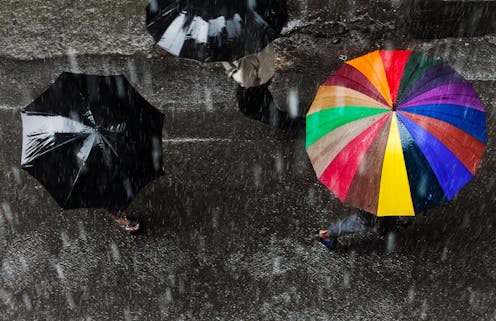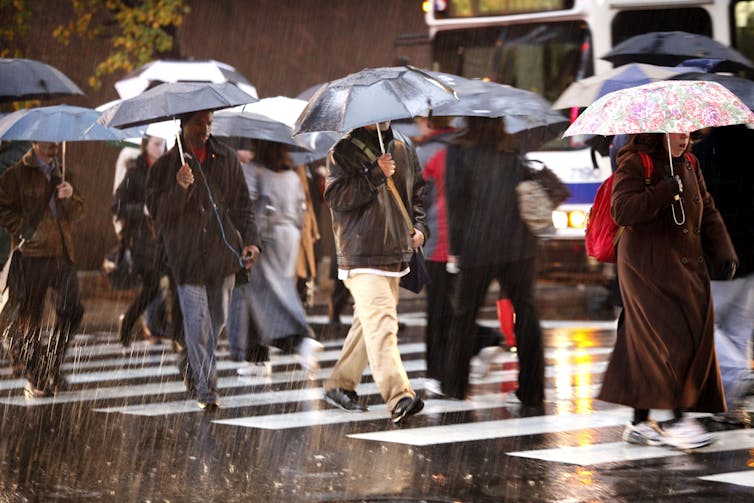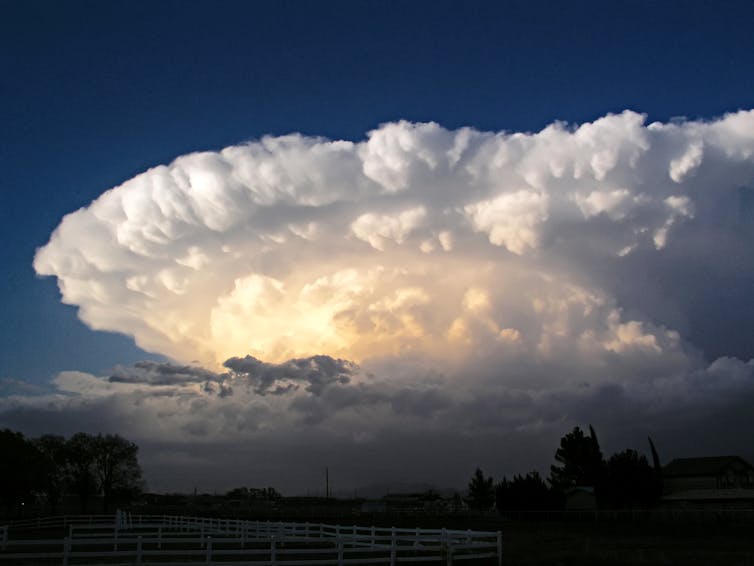Why does some rain fall harder than other rain?
Some rainstorms drench you in a second, while others drop rain in a nice peaceful drizzle. A meteorologist explains how rainstorms can be so different.


Curious Kids is a series for children of all ages. If you have a question you’d like an expert to answer, send it to curiouskidsus@theconversation.com.
Why does some rain fall harder than other rain? – Naomi B., age 9, San Fancisco, California
There are some days when the rain falls peacefully and gently, nourishing the Earth. But on some other days the rain comes down in a torrential downpour that meteorologists like me call a cloudburst. Standing outside in one of these intense rainstorms can feel like being smothered in a heavy, wet towel. These storms can flood the lands below them and lead to great destruction.
So what causes this difference?
All rain comes from a combination of two things: moisture in the air – usually in the form of clouds – and currents of air moving upwards. As moist air rises up through a cloud, the air cools and the water in it turns into tiny raindrops.
This is the same thing that happens when you can see your breath on a cold evening. The temperature change from warm to cool causes water droplets to form in your breath.
In a cloud, these tiny raindrops are very light and float as the rising air pushes them up. But the higher they go, the larger and heavier they get. Eventually, they get so heavy that they fall to the Earth as rain.

Cold air storms are steady and slow
Cold air can hold much less moisture than warm air, so wintertime clouds don’t have much water in them; they are thin and layered rather than puffy and tall and full of water.
Since cold air likes to sink to the ground, it’s difficult to get that air to rise quickly, so these wintertime clouds have only gentle upward air currents. As these slow currents sweep up through the thin clouds that don’t have much moisture, small raindrops form. Gravity easily pulls them down against the air current before they get too big. When clouds are thin and the air is moving slowly, you get nice calm rain.

Thunderstorms and big winter storms are quick and intense
Hard rainstorms happen when there is a lot of moisture in the air and the air moves upwards very fast. Summer thunderstorms are the perfect example.
The warm, moist air rises very quickly – like a hot air balloon – and can be moving as fast as 30 to 40 miles per hour. The air also holds much more moisture than winter clouds – up to five times as much.
All of this creates very tall, thick clouds that are full of moisture. Water droplets form quickly as the air moves up through the clouds. But since the wind is blowing upwards so fast, the droplets can get huge before gravity drags them down to Earth. When the weight of all the water droplets gets to be too much for the wind, the wind current collapses, and all the raindrops in the cloud come crashing down at once. These are summer thunderstorms.
Thunderstorms can drop one, two or even three inches of rain in less than an hour. These sudden torrential downpours, called cloudbursts, can lead to flash flooding that can overflow streams and roads and trap people wherever they are.
[The Conversation’s science, health and technology editors pick their favorite stories. Weekly on Wednesdays.]
Thankfully, because thunderstorms are so violent and relatively small, they don’t last very long. Once the rain falls from the clouds and squashes the upward air currents, the clouds disappear and you often see a nice blue sky.
Of course, winter can deliver some strong storms too – especially over the warmer ocean water. When strong winter storms drop lots of heavy rain, the same principles are at work: lots of moisture in the air, fast upwards wind currents and tall clouds.
No two rainstorms are ever the same. Sometimes clouds can rain so hard it feels like you are standing in the shower. Other times they bring only a nice peaceful drizzle. Now, whether you are soaked or singing in the rain, you’ll know why.
Hello, curious kids! Do you have a question you’d like an expert to answer? Ask an adult to send your question to curiouskidsus@theconversation.com.
Please tell us your name, age and the city where you live. We won’t be able to answer every question, but we will do our best.
Jeffrey B. Halverson does not work for, consult, own shares in or receive funding from any company or organization that would benefit from this article, and has disclosed no relevant affiliations beyond their academic appointment.
Read These Next
Meditating on the connectedness of life could help reunite a divided country – here’s how ‘interbein
Meditation can change our perceptions about things we encounter in our daily lives − revealing the…
Facing myriad global pressures, Iran intensifies outreach to African partners for critical needs
Iran has sought to bolster its economic and security relationships on the continent after a punishing…
The housing crisis is forcing Americans to choose between affordability and safety
Priced out of ‘safe,’ more and more Americans are moving to flood plains and fire zones.






